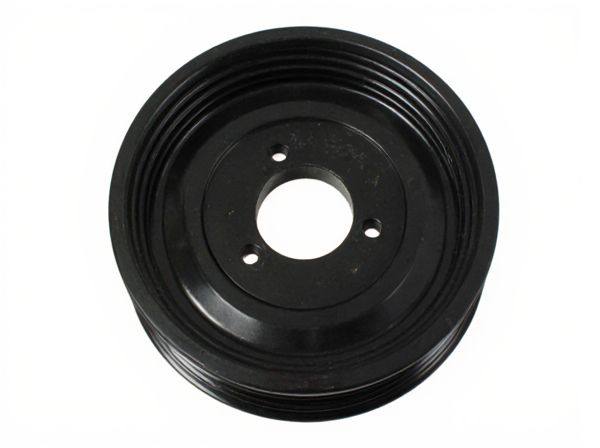
Photo illustration: Single Groove Pulley vs Multi-Groove Pulley
Single groove pulleys are designed for applications requiring straightforward power transmission to one belt, making them ideal for simple machinery with limited load demands. Multi-groove pulleys increase power transmission capacity by accommodating several belts simultaneously, enhancing grip and reducing slippage in more complex or high-torque systems. Choosing the right pulley ensures your equipment operates efficiently, matching load requirements and preventing premature wear.
Table of Comparison
| Feature | Single Groove Pulley | Multi-Groove Pulley |
|---|---|---|
| Function | Drives alternator with one belt groove | Drives alternator with multiple belt grooves for higher grip |
| Performance | Lower torque transmission | Higher torque transmission, efficient power delivery |
| Durability | Prone to belt slippage, faster wear | Reduced slippage, longer belt life |
| Maintenance | Frequent belt replacement due to wear | Less frequent maintenance, improved reliability |
| Cost | Generally lower initial cost | Higher upfront cost but cost-effective over time |
| Application | Suitable for low to moderate power alternators | Ideal for high power alternators and demanding applications |
Introduction to Pulley Systems
Pulley systems utilize single groove pulleys for driving a single belt, optimizing simplicity and ease of maintenance in machinery. Multi-groove pulleys accommodate multiple belts simultaneously, enhancing power transmission capacity and reducing slippage in high-torque applications. Selection between these pulley types depends on load requirements, space constraints, and mechanical efficiency needs in industrial equipment.
What is a Single Groove Pulley?
A Single Groove Pulley features one continuous groove along its circumference, designed to guide and support a single belt or rope for power transmission or mechanical movement. This pulley type offers simplicity and ease of maintenance, making it ideal for applications where only one linear force transmission is required. Unlike multi-groove pulleys, single groove pulleys reduce belt wear and alignment issues by limiting the belt to a single track.
What is a Multi-Groove Pulley?
A multi-groove pulley features multiple parallel grooves designed to accommodate several belts simultaneously, increasing power transmission capacity and reducing slippage compared to single groove pulleys. This design improves load distribution and enhances mechanical efficiency in industrial applications such as conveyor systems and automotive engines. By using multiple belts, multi-groove pulleys provide greater durability and reliability in high-torque environments.
Key Differences Between Single and Multi-Groove Pulleys
Single groove pulleys feature one channel for belt engagement, providing simplicity and ease of maintenance, making them ideal for lower power transmission applications. Multi-groove pulleys incorporate multiple channels, allowing simultaneous belt usage, which increases load capacity, improves power transmission efficiency, and reduces slippage. The choice between single and multi-groove pulleys depends on factors like torque requirements, space constraints, and desired system reliability.
Performance and Efficiency Comparison
Single groove pulleys offer straightforward design and are suitable for low power transmission with minimal slippage, but they often deliver lower torque capacity compared to multi-groove pulleys. Multi-groove pulleys enhance belt grip and increase power transmission efficiency by distributing load across multiple contact points, reducing wear and improving durability under high torque conditions. Efficiency gains in multi-groove systems typically translate to reduced energy losses and longer belt life, making them preferable in high-performance industrial applications.
Applications of Single Groove Pulleys
Single groove pulleys are commonly used in applications requiring moderate power transmission and simple belt alignment, such as in household appliances, small machinery, and conveyors. Their single groove design ensures ease of installation and maintenance, making them ideal for systems with straightforward mechanical requirements. These pulleys support efficient power transfer in light to medium-duty operations where multi-belt configurations are unnecessary.
Applications of Multi-Groove Pulleys
Multi-groove pulleys are widely used in automotive engines, industrial machinery, and HVAC systems due to their ability to transfer higher torque and accommodate multiple belts, enhancing power transmission efficiency. These pulleys minimize slippage and distribute load evenly across belts, making them ideal for heavy-duty applications and complex mechanical setups. Their design supports synchronized operation of multiple components, improving reliability and reducing maintenance in conveyor systems and agricultural equipment.
Advantages and Disadvantages of Each Type
Single groove pulleys offer simplicity, lower cost, and easier maintenance, making them ideal for low to moderate power transmission applications but are limited in load capacity and prone to slippage under high torque. Multi-groove pulleys provide enhanced grip, increased power transmission efficiency, and reduced belt wear by distributing load across multiple grooves, yet they are more expensive, complex to install, and require precise alignment to prevent premature belt failure. Selecting between single and multi-groove pulleys depends on balancing system power requirements, cost constraints, and maintenance capabilities.
Choosing the Right Pulley for Your Needs
Selecting the right pulley depends on the power transmission requirements and space constraints of your application. Single groove pulleys are ideal for simple, low-power systems requiring minimal alignment, while multi-groove pulleys handle higher torque loads and offer increased belt contact area to reduce slippage. Evaluating factors such as load capacity, belt type, and operational speed ensures optimal performance and longevity for your mechanical setup.
Conclusion: Single Groove vs Multi-Groove Pulley
Single groove pulleys provide simplicity and are ideal for applications requiring low power transmission and limited belt alignment, while multi-groove pulleys offer enhanced grip, increased power capacity, and reduced slippage by accommodating multiple belts simultaneously. Selecting between single and multi-groove pulleys depends on factors such as load requirements, space constraints, and efficiency needs, with multi-groove pulleys favored in heavy-duty or high-torque scenarios. Optimizing pulley choice improves system durability, performance, and maintenance efficiency.
 caratoz.com
caratoz.com